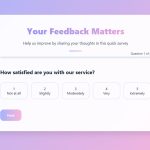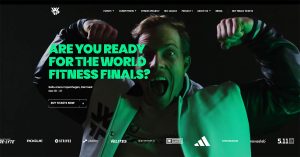Empty rooms generate zero revenue. That’s the brutal math every hotelier faces daily. Lead generation for hotels solves this problem by building a consistent pipeline of potential guests before they…
Table of Contents
Your email list sits empty while competitors build audiences of thousands. The difference? They’re offering something valuable upfront.
Lead magnet ideas transform casual website visitors into engaged subscribers by exchanging useful resources for contact information. But generic “subscribe to our newsletter” forms convert at dismal rates because they offer nothing compelling.
The right lead magnet solves specific problems your target audience actually faces. Whether you need a free downloadable resource, an email course, or exclusive webinar access, choosing the wrong format wastes time and budget.
This guide breaks down proven lead magnet types with conversion data, creation requirements, and distribution strategies. You’ll discover which formats work best for your business model and how to optimize them for maximum email list growth.
Lead Magnet Ideas
| Lead Magnet Type | Primary Value Attribute | Implementation Effort | Conversion Context |
|---|---|---|---|
| Free Ebook or Guide | Comprehensive knowledge transfer on specific topic with structured information hierarchy | High (requires extensive content creation, design, formatting) | Educational content seekers, early-stage awareness prospects |
| Checklist or Cheat Sheet | Quick-reference actionable steps for immediate task completion | Low (simple list format, minimal design requirements) | Action-oriented users seeking immediate practical implementation |
| Email Course | Sequential learning delivery with sustained engagement over multiple days | Medium (requires email sequence setup, automation configuration) | Committed learners, higher engagement intent, nurture-focused prospects |
| Webinar or Workshop | Live interactive instruction with real-time question resolution capability | High (platform setup, presentation preparation, live delivery time) | High-intent prospects, relationship-building scenarios, consultative sales |
| Template or Workbook | Ready-to-use framework providing structured implementation pathway | Medium (document creation, instructions, fillable format design) | Hands-on practitioners, DIY-focused audience, process-oriented users |
| Free Trial or Demo | Direct product experience enabling hands-on evaluation before purchase | High (technical implementation, account management, support infrastructure) | Bottom-funnel prospects, software/service buyers, decision-stage users |
| Resource Library Access | Curated collection of multiple assets providing ongoing reference value | High (content aggregation, organization system, access management) | Professional researchers, continuous learners, industry professionals |
| Quiz or Assessment | Personalized insights through interactive diagnostic evaluation mechanism | Medium (question development, logic programming, results interpretation) | Self-discovery seekers, personalization-responsive audience, awareness-stage |
| Case Study or White Paper | Evidence-based credibility through documented real-world implementation results | High (research, data collection, professional writing, design) | B2B decision-makers, analytical buyers, enterprise-level prospects |
| Discount or Coupon Code | Immediate financial incentive reducing purchase barrier through price reduction | Low (code generation, email delivery, tracking setup) | Price-sensitive buyers, ready-to-purchase prospects, promotional campaigns |
| Tool or Calculator | Automated computation delivering instant customized numerical results | High (development, testing, UI/UX design, maintenance) | Data-driven professionals, ROI-focused buyers, technical audiences |
| Video Tutorial Series | Visual step-by-step demonstration showing exact execution methodology | High (filming, editing, hosting, thumbnail design) | Visual learners, technical skill-builders, demonstration-preference audience |
| Swipe File | Proven example collection providing inspiration through successful models | Medium (curation, organization, permissions, commentary addition) | Creative professionals, marketers, copywriters, design-focused users |
| Challenge (5-day, 7-day) | Structured accountability program creating momentum through daily participation | High (daily content creation, community management, support system) | Motivation-driven individuals, community-oriented learners, transformation seekers |
| Mini-Course | Condensed educational program delivering focused skill development outcome | High (curriculum design, content creation, platform setup) | Committed learners, career advancers, skill-gap closers |
| Printable Planner | Physical organization tool enabling tangible planning and tracking system | Medium (design, layout creation, PDF formatting, print optimization) | Offline planners, tactile-preference users, organization enthusiasts |
| Script or Framework | Pre-written conversation guide reducing uncertainty in communication scenarios | Medium (scenario analysis, script writing, customization options) | Sales professionals, customer service teams, communication-focused roles |
| Exclusive Report | Proprietary research findings offering unique market intelligence unavailable elsewhere | High (original research, data analysis, professional presentation) | Strategic decision-makers, industry analysts, competitive intelligence seekers |
| Toolkit or Bundle | Comprehensive resource package combining multiple complementary assets together | High (multiple asset creation, packaging, cohesive organization) | Solution-seekers, high-value prospects, complete-system preference users |
| Free Consultation | Personalized expert advice session providing customized strategic recommendations | High (time commitment, scheduling system, expertise delivery) | High-ticket prospects, service-based sales, relationship-dependent conversions |
Free Ebook or Guide

Digital books remain one of the most recognized downloadable resources for email list building. These comprehensive documents package your expertise into a format people already trust and know how to consume.
Target Audience
Works best for B2B companies, consultants, coaches, and educational businesses targeting decision-makers who need in-depth information before making purchasing decisions. Professional audiences aged 30-55 show the highest engagement with this format.
Core Value Proposition
Solves complex problems that require detailed explanations, step-by-step processes, or comprehensive frameworks. The average ebook delivers 5,000 to 10,000 words of actionable content that readers can reference repeatedly.
Content Format
Delivered as PDF documents, typically 15-30 pages in length. Short-form ebooks under 30 pages convert better than longer versions. Include clickable table of contents, visual elements, and clear section breaks for easy scanning.
Creation Requirements
- Time investment: 20-40 hours for research, writing, and design
- Tools needed: Google Docs, Microsoft Word, Canva, or Adobe InDesign
- Expertise level: Intermediate writing and basic design skills
- Additional resources: Stock images, brand guidelines, PDF conversion software
Distribution Channels
Landing pages paired with targeted social media ads perform best. Email marketing achieves the highest channel-to-lead conversion rates at 12% in certain industries. Popup forms can increase conversion by 100-155% when offering ebook downloads.
Conversion Optimization
Use benefit-focused headlines rather than generic titles. Test different page layouts using multi-step forms versus single-step options. Position the download button above the fold with contrasting colors. Include a preview or sample chapter to reduce perceived risk.
Related Entities
Often paired with email courses, webinars, and content upgrades. Consider creating checklist companions or template libraries that complement your ebook’s main topics.
Checklist or Cheat Sheet

Quick-reference documents that break down complex processes into scannable action items. These short-form resources win on simplicity and immediate utility.
Target Audience
Time-strapped professionals, solopreneurs, and anyone implementing new processes or systems. Particularly effective for audiences who value efficiency and actionable steps over theory.
Core Value Proposition
Eliminates decision fatigue by providing a clear path forward. Reduces implementation time by organizing scattered information into sequential steps. Over 58% of marketers report that checklists and similar short-form content generate higher conversion rates than long-form alternatives.
Content Format
One-page PDF or printable document with checkboxes, bullet points, and clear headings. Digital versions work in Google Sheets for interactive tracking. Keep text minimal with white space for visual clarity.
Creation Requirements
- Time investment: 2-5 hours for planning, writing, and formatting
- Tools needed: Canva, Google Docs, or Notion
- Expertise level: Basic (easier than ebooks)
- Minimal design skills required
Distribution Channels
Performs exceptionally well in blog post content upgrades. Exit-intent popups offering checklists capture abandoning visitors effectively. Social media posts linking to dedicated landing pages also drive significant downloads.
Conversion Optimization
Use specific numbers in titles (“47-Point SEO Checklist” performs better than “Complete SEO Checklist”). Design for mobile viewing since many users access checklists on phones. Add your logo and website URL for brand recognition when users share or save the document.
Related Entities
Often bundled with templates, workbooks, or video tutorials. Natural companion to email courses that walk through each checklist item in detail.
Email Course

Sequential lessons delivered directly to subscriber inboxes over multiple days or weeks. This format builds ongoing engagement rather than one-time downloads.
Target Audience
Learners who prefer structured, bite-sized information over comprehensive downloads. Works for educational brands, course creators, and businesses with longer sales cycles requiring extended nurturing.
Core Value Proposition
Transforms passive subscribers into active learners through scheduled delivery. Builds familiarity with your brand voice and teaching style before presenting paid offerings. Creates habit formation through consistent inbox presence.
Content Format
5-10 emails containing 300-800 words each, delivered on a preset schedule (daily, every other day, or weekly). Each email focuses on one concept with clear next steps. Include visual elements sparingly to maintain fast load times.
Creation Requirements
- Time investment: 15-25 hours for curriculum planning and writing
- Tools needed: Email service provider with automation features
- Expertise level: Intermediate email copywriting
- Technical setup: Email automation sequences
Distribution Channels
Native email platforms provide the delivery mechanism. Promote through blog posts, social media campaigns, and dedicated landing page forms. Partner webinars and guest posts can drive qualified signups.
Conversion Optimization
Create curiosity gaps in your promotional copy by revealing lesson topics without full details. Use registration forms that ask only for email addresses to reduce friction. Send a welcome email immediately after signup with lesson one to maintain momentum.
Related Entities
Works alongside webinar funnels, membership site previews, and paid course launches. Often serves as a bridge between free content and premium products.
Webinar or Workshop
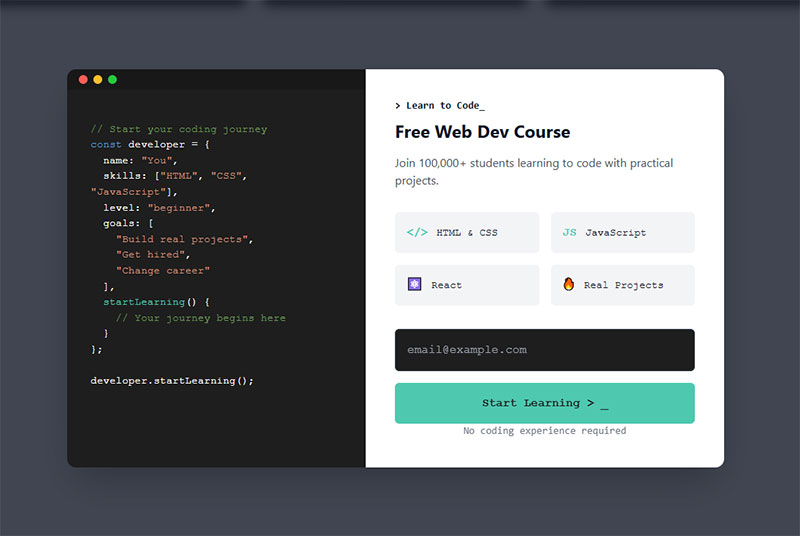
Live or recorded virtual events featuring presentations, demonstrations, and real-time interaction. These create high-touch experiences that build trust rapidly.
Target Audience
B2B professionals, high-ticket service buyers, and anyone making considered purchases requiring validation. Particularly effective for software companies, consultants, and complex service providers.
Core Value Proposition
Delivers 70.2% conversion rates among long-form video formats. Provides face-to-face connection even in remote settings. Demonstrates expertise through live problem-solving and Q&A sessions. About 73% of B2B webinar attendees become qualified leads.
Content Format
45-90 minute presentations combining slides, screen shares, and speaker video. Include polls, Q&A segments, and downloadable resources mentioned during the session. Record everything for on-demand viewing.
Creation Requirements
- Time investment: 30-50 hours for content development, slides, and promotion
- Tools needed: Webinar platform (Zoom, WebinarJam), presentation software, recording equipment
- Expertise level: Advanced presentation and technical skills
- Additional requirements: Stable internet, quality microphone, practice run-throughs
Distribution Channels
Email marketing drives 57% of webinar registrations. Promote through webinar registration forms optimized for mobile devices. Social media posts, LinkedIn outreach, and partner promotions amplify reach.
Conversion Optimization
Registration pages can achieve up to 59% conversion rates with proper design. Send reminder emails (increases attendance by 20%). Start promotions four weeks before the event for 12% higher registrations. Use form validation to reduce incomplete submissions.
Related Entities
Pairs with case studies, product demos, and exclusive reports shared during or after the presentation. Natural precursor to free consultations or sales calls.
Template or Workbook

Fill-in-the-blank frameworks, spreadsheets, and interactive documents that users customize for their specific needs. These provide immediate implementation value.
Target Audience
Practitioners who need structured approaches to common tasks. Marketers, designers, financial planners, and project managers rely heavily on templates to accelerate work.
Core Value Proposition
Eliminates “blank page syndrome” by providing proven structures. Reduces time investment from hours to minutes for routine tasks. Delivers instant gratification since users can apply templates immediately after download.
Content Format
Google Sheets, Excel files, Notion templates, Canva designs, or PDF fillable forms. Editable formats perform better than static PDFs since users can personalize content. Include instruction tabs or embedded tooltips for guidance.
Creation Requirements
- Time investment: 5-15 hours depending on complexity
- Tools needed: Google Workspace, Microsoft Office, Canva, Notion, or Airtable
- Expertise level: Intermediate knowledge of the tool and the problem being solved
- Design considerations: Clear labels, example data, and intuitive structure
Distribution Channels
Landing pages with preview images showing template in action. Content marketing through blog tutorials demonstrating template usage. Social proof works well here, so display download counts or testimonials.
Conversion Optimization
Show before/after examples or screenshots of the template in use. Offer “view before download” options to reduce uncertainty. Use lead capture forms that emphasize quick access with phrases like “Get Instant Access.”
Related Entities
Bundle multiple templates into toolkits. Complement with video tutorials, case studies showing template applications, or advanced versions as paid upgrades.
Free Trial or Demo

Limited-time access to paid products or services. This reduces purchase risk by letting prospects experience value before financial commitment.
Target Audience
SaaS companies, software developers, subscription businesses, and high-consideration service providers. Best for products with clear value propositions that reveal themselves quickly through use.
Core Value Proposition
Converts skeptical prospects into users through direct experience. Removes purchase objections by proving functionality, ease of use, and ROI before asking for payment. Trial users convert at higher rates than cold prospects.
Content Format
Time-limited (7-30 days) or feature-limited access to full product. Includes onboarding sequences, tutorial videos, and support documentation. Some businesses offer demo accounts with sample data pre-loaded.
Creation Requirements
- Time investment: 40-100 hours for trial infrastructure, onboarding flows, and monitoring systems
- Tools needed: Account management software, analytics platforms, automated email sequences
- Expertise level: Advanced technical implementation
- Ongoing maintenance: Customer support, usage monitoring, conversion tracking
Distribution Channels
Product landing pages with clear trial signup forms. Partner integrations, comparison websites, and review platforms. Retargeting campaigns to website visitors who viewed pricing pages.
Conversion Optimization
Reduce signup friction by eliminating credit card requirements during trial signup. Send behavior-triggered emails based on feature usage. Use conditional logic in forms to segment users and personalize onboarding experiences.
Related Entities
Often combined with product walkthroughs, implementation guides, and case studies. Natural integration with consultation calls or demo presentations.
Resource Library Access
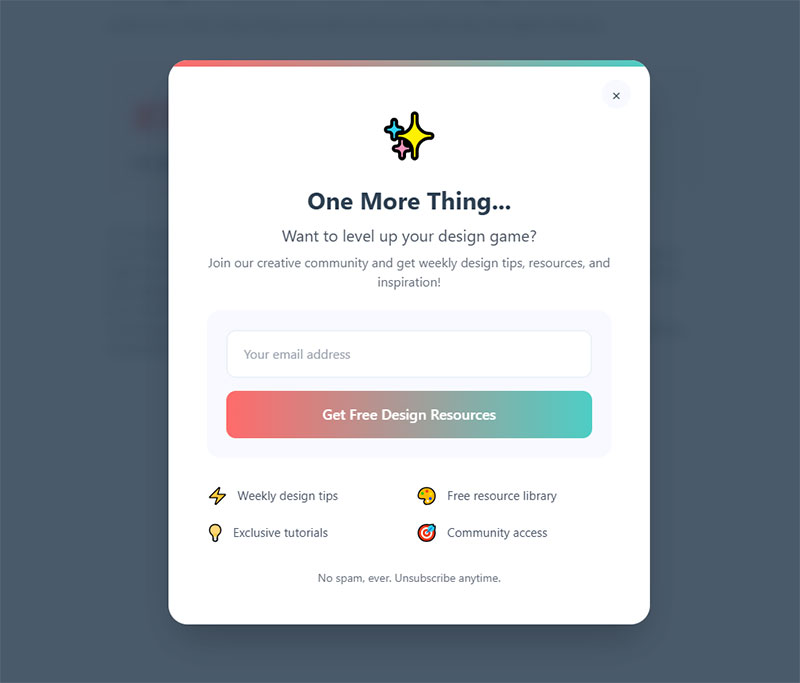
Curated collections of tools, templates, guides, and resources locked behind an email gate. These provide ongoing value rather than single downloads.
Target Audience
Content consumers who value comprehensive references. Agencies, consultants, and educators building resource centers for their audiences. Works for businesses creating community around their expertise.
Core Value Proposition
Delivers multiple resources in exchange for one opt-in, increasing perceived value significantly. Creates destination content that attracts backlinks and search traffic. Encourages repeated engagement with your brand as users return for new resources.
Content Format
Password-protected web pages, membership areas, or regularly updated repositories. Organize by category, skill level, or problem type. Include search functionality for larger libraries with 15+ resources.
Creation Requirements
- Time investment: 50-100 hours for initial library setup plus ongoing content creation
- Tools needed: Membership plugin, content management system, file hosting
- Expertise level: Intermediate web development or WordPress skills
- Maintenance requirements: Regular content updates, broken link checking
Distribution Channels
Dedicated landing pages with compelling resource previews. Gated content promoted through SEO-optimized blog posts. Social media campaigns highlighting specific library items.
Conversion Optimization
Display resource counts and categories on opt-in pages (“Access 75+ Templates in 12 Categories”). Show preview images or thumbnails of included items. Use progressive profiling in your subscription forms to gather additional data over time without overwhelming initial signup.
Related Entities
Combines naturally with email newsletters announcing new additions, member-only webinars, and community forum access. Can evolve into paid membership offerings.
Quiz or Assessment
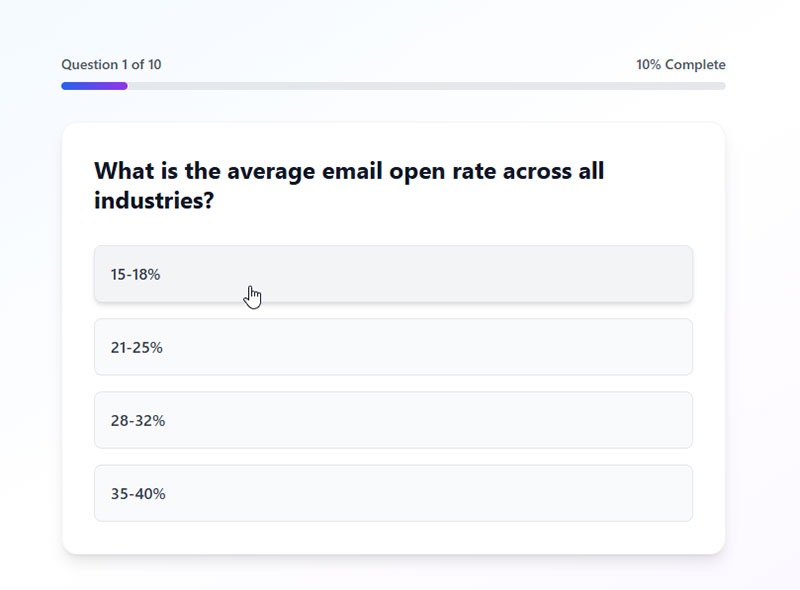
Interactive tools that provide personalized results based on user responses. These engage visitors while collecting valuable segmentation data.
Target Audience
Businesses needing deep audience insights and segmentation capabilities. E-commerce brands, service providers, and coaches who customize offerings based on individual needs or characteristics.
Core Value Proposition
Generates 35% conversion rates compared to 11% for general lead generation forms. Creates personalized experiences that resonate more than generic content. Collects zero-party data that improves email personalization and targeting.
Content Format
Web-based interactive forms with 5-15 questions leading to customized results pages. Include visual elements, progress indicators, and shareable results. Results pages should provide actionable insights, not just scores.
Creation Requirements
- Time investment: 20-40 hours for question development, logic mapping, and results creation
- Tools needed: Quiz platforms, form builders with conditional logic, or custom development
- Expertise level: Intermediate for template-based tools, advanced for custom builds
- Design requirements: Engaging visuals, mobile optimization
Distribution Channels
Dedicated quiz landing pages promoted through paid social media advertising. Embedded within blog content as interactive elements. Using quizzes effectively requires testing different quiz titles and promotional angles.
Conversion Optimization
Gate results after question completion rather than before quiz start to increase completion rates. Make questions enjoyable and relevant, not data collection exercises. Share sample results or testimonials to build curiosity. Ensure form accessibility for all users.
Related Entities
Follow up with customized product recommendations, personalized content series, or consultation offers based on quiz results. Works well alongside case studies and testimonials.
Case Study or White Paper

In-depth analyses, research reports, and success stories documenting real results or industry insights. These establish credibility for complex offerings.
Target Audience
B2B decision-makers, technical buyers, and stakeholders requiring evidence before making purchasing decisions. Industries with longer sales cycles like enterprise software, healthcare, and financial services.
Core Value Proposition
Provides social proof through documented results with specific metrics. Demonstrates thought leadership and industry expertise. Helps prospects visualize success scenarios and ROI potential for their organizations.
Content Format
PDF documents ranging from 8-25 pages. Include executive summaries, methodology sections, quantified results, and visual data representations. Case studies focus on customer stories while white papers present research or industry analysis.
Creation Requirements
- Time investment: 30-60 hours for research, interviews, writing, and design
- Tools needed: Research tools, design software, data visualization platforms
- Expertise level: Advanced writing and analytical skills
- Additional needs: Subject matter experts, customer interviews, proprietary data
Distribution Channels
Lead generation forms on dedicated landing pages. Sales team resources for mid-funnel prospects. Referenced in webinars and email campaigns. Partner with industry publications for extended reach.
Conversion Optimization
Write compelling headlines that highlight specific outcomes (“How Company X Increased Revenue 340% in 6 Months”). Include preview sections or key findings before the download gate. Promote real numbers and timeframes in ad copy and landing pages.
Related Entities
Natural companion to webinars, consultation offers, and product demos. Often referenced in sales presentations and proposal documents.
Discount or Coupon Code
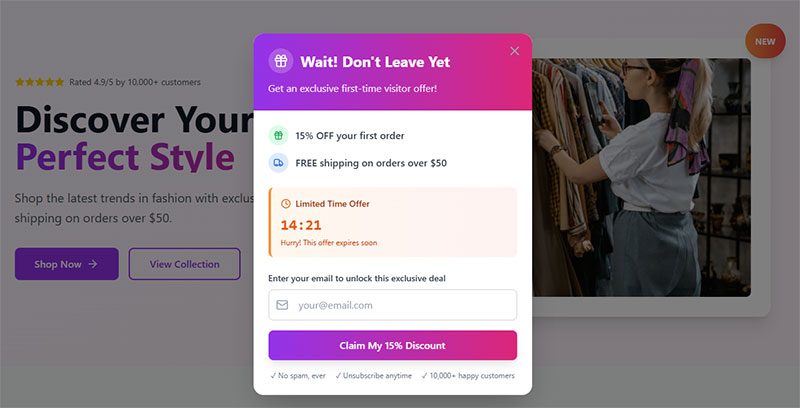
Immediate financial incentives for first-time purchases. These work best for transactional businesses where price sensitivity drives decisions.
Target Audience
E-commerce shoppers, retail customers, and price-conscious consumers. Particularly effective in B2C markets and for lower-consideration purchases under $200.
Core Value Proposition
Removes price objections and creates urgency through limited-time offers. Provides clear, quantifiable value that requires no time investment to understand. Converts window shoppers into buyers through reduced financial risk.
Content Format
Unique coupon codes delivered via email, displayed on exit intent popups, or provided through SMS. Include expiration dates, usage restrictions, and clear redemption instructions.
Creation Requirements
- Time investment: 2-5 hours for code generation, email setup, and promotion planning
- Tools needed: E-commerce platform with coupon functionality, email service provider
- Expertise level: Basic technical skills
- Additional setup: Checkout optimization to ensure smooth redemption process
Distribution Channels
Exit-intent forms capturing abandoning visitors. Welcome series for new email subscribers. Social media campaigns and influencer partnerships. Performs particularly well for lead generation in e-commerce.
Conversion Optimization
Test discount amounts (percentage vs. dollar value) for different products. Add countdown timers to create urgency. Display the savings amount prominently. Use GDPR compliant forms when collecting customer data for coupon delivery.
Related Entities
Combines with abandoned cart recovery campaigns, loyalty programs, and referral incentives. Follow up with post-purchase surveys and review requests.
Tool or Calculator
Interactive utilities that solve specific calculations or provide customized outputs based on user inputs. These deliver instant, personalized value.
Target Audience
Data-driven professionals needing quick calculations. Finance, real estate, health, fitness, and marketing industries rely heavily on calculators for decision-making support.
Core Value Proposition
Provides immediate utility and “wow factor” through interactivity. Creates bookmarkable resources people return to repeatedly. Generates backlinks and organic traffic through unique functionality not available elsewhere.
Content Format
Web-based tools embedded directly in pages or accessed through member areas. Include input fields, real-time calculations, downloadable results, and explanation of methodology. Mobile-responsive design is crucial since many users access calculators on phones.
Creation Requirements
- Time investment: 40-80 hours for logic development, design, and testing
- Tools needed: JavaScript knowledge, form builders, or specialized calculator platforms
- Expertise level: Advanced technical skills for custom builds
- Ongoing maintenance: Formula updates, bug fixes, accuracy verification
Distribution Channels
SEO-optimized landing pages targeting calculator-related keywords. Embedded within relevant blog content. Promoted through industry forums and social media groups where your target audience discusses related problems.
Conversion Optimization
Gate results after users input their data rather than before to increase completion rates. Email personalized results with additional resources. Add social sharing buttons so users can spread the tool organically. Use website forms for lead generation to capture calculator users.
Related Entities
Often paired with detailed guides explaining results, consultation offers for personalized analysis, or paid tools with advanced functionality.
Video Tutorial Series
Sequential video lessons teaching specific skills or processes. These combine visual demonstration with structured learning paths.
Target Audience
Visual learners preferring step-by-step demonstrations over written instructions. Works for software training, creative skills, DIY projects, and any topic benefiting from visual explanation.
Core Value Proposition
Delivers 55.7% conversion rates for short video clips. Shows rather than tells, reducing learning curves for complex topics. Creates personal connection through face and voice recognition. Videos generate higher engagement and attention retention than text.
Content Format
3-7 videos ranging from 3-15 minutes each. Host on YouTube, Vimeo, or course platforms. Include downloadable transcripts, resource links, and practice files. Organize in logical progression from beginner to intermediate concepts.
Creation Requirements
- Time investment: 50-80 hours for scripting, recording, editing, and uploading
- Tools needed: Video camera or screen recorder, editing software, hosting platform
- Expertise level: Intermediate video production skills
- Additional equipment: Microphone, lighting, teleprompter (optional)
Distribution Channels
YouTube channel with gated access to full series. Embedded video players on landing pages with video form fields capturing emails at strategic points. Social media teasers linking to complete series signup.
Conversion Optimization
Release first video publicly to demonstrate value, then gate remaining episodes. Include chapter markers for longer videos. Add calls-to-action within videos and descriptions. Test thumbnail images and titles for maximum click-through rates.
Related Entities
Complement with downloadable workbooks, live Q&A sessions, and community forum access. Natural progression to paid courses or certification programs.
Swipe File
Collections of proven examples, templates, or reference materials that users can model their own work after. These eliminate creative blocks.
Target Audience
Marketers, copywriters, designers, and anyone creating similar work repeatedly who needs inspiration and proven formats. Works well for creative professionals seeking to improve craft.
Core Value Proposition
Saves hours of research by compiling best-in-class examples in one location. Provides pattern recognition showing what works across multiple contexts. Offers direct competitive intelligence users can’t easily compile themselves.
Content Format
Curated PDF collections, Google Drive folders, or web galleries featuring screenshots, links, and examples. Organize by category, industry, or success metric. Include brief annotations explaining why each example works.
Creation Requirements
- Time investment: 15-30 hours for research, curation, organization, and annotation
- Tools needed: Screenshot tools, design software, organizational systems
- Expertise level: Intermediate curation and analytical skills
- Update frequency: Quarterly additions maintain value
Distribution Channels
Landing pages emphasizing collection size and example quality (“100+ High-Converting Email Subject Lines”). Referenced in blog posts analyzing specific examples. Social media snippets showcasing individual items from the collection.
Conversion Optimization
Display preview examples on the opt-in page so visitors see actual quality. Use specific numbers in titles. Segment swipe files by industry or use case. Create urgency by mentioning limited-time inclusions of recent examples.
Related Entities
Package with analysis documents, video breakdowns, or templates based on the examples. Consider annual updated versions as continuity products.
Challenge (5-Day, 7-Day, etc.)
Structured programs guiding participants through daily tasks over a set timeframe. These combine accountability with community and momentum.
Target Audience
Action-oriented learners who thrive with structure and deadlines. Fitness, productivity, creative, and self-improvement niches see particularly strong results. Works for audiences struggling with procrastination or overwhelm.
Core Value Proposition
Creates measurable progress through small daily wins building toward significant transformation. Builds community among participants going through the same journey. Generates urgency and commitment through defined start and end dates.
Content Format
Daily emails or social media posts delivering one task, lesson, or exercise. Typically runs 5-7 days to maintain momentum without overwhelming participants. Include progress tracking worksheets, community discussion space, and completion certificates.
Creation Requirements
- Time investment: 25-40 hours for content creation, automation setup, and community management
- Tools needed: Email automation platform, community space (Facebook Group, Slack, Discord)
- Expertise level: Intermediate planning and teaching skills
- Ongoing involvement: Daily engagement during active challenge periods
Distribution Channels
Landing pages emphasizing start dates and community aspect. Event registration forms collecting participant information. Social media countdowns building anticipation before launch dates.
Conversion Optimization
Run challenges on specific dates rather than evergreen automation to create urgency. Show previous participant results and testimonials. Offer bonus resources for early registration. Use feedback forms post-challenge to gather improvement insights.
Related Entities
Natural bridge to paid programs, coaching offers, or extended courses. Often includes live Q&A sessions, private community access, and certificate of completion.
Mini-Course
Compact learning experiences teaching specific skills in 3-5 lessons. These sit between email courses and full online courses in scope and depth.
Target Audience
Motivated learners seeking structured education on focused topics. Course creators testing market demand before building comprehensive programs. Businesses positioning themselves as educational authorities.
Core Value Proposition
Delivers complete skill development in digestible format. Demonstrates teaching style and curriculum quality as preview of paid offerings. Creates completion satisfaction unlike sprawling courses that overwhelm students.
Content Format
3-5 modules combining video, text, worksheets, and quizzes hosted on course platforms or delivered via email. Each module should be completable in 15-30 minutes. Include progress tracking and completion certificates.
Creation Requirements
- Time investment: 40-70 hours for curriculum design, content creation, and platform setup
- Tools needed: Course hosting platform (Teachable, Thinkific), video equipment, design software
- Expertise level: Advanced instructional design and content creation
- Technical requirements: LMS setup, student management systems
Distribution Channels
Dedicated course landing pages with registration form templates optimized for course signups. Webinar participants receive mini-courses as follow-up resources. Blog content marketing demonstrating expertise in course topics.
Conversion Optimization
Emphasize specific outcomes (“Build Your First Website in 5 Days” vs. “Learn Web Development”). Show course curriculum and time investment upfront. Include instructor credentials and student testimonials. Use multi-step forms to reduce initial signup friction.
Related Entities
Leads naturally to paid course upgrades, certification programs, or coaching packages. Often includes community forum access and live office hours.
Printable Planner

Physical or digital planners helping users organize tasks, goals, or projects. These provide ongoing utility beyond single-use resources.
Target Audience
Organization-focused individuals in productivity, wellness, finance, and planning niches. Parents, students, professionals, and anyone managing complex schedules or projects.
Core Value Proposition
Creates daily interaction with your brand as users reference the planner repeatedly. Provides tangible value through structure and organization support. Visual appeal makes planners highly shareable on social media platforms like Pinterest.
Content Format
PDF files designed for printing or digital note-taking apps. Include daily, weekly, and monthly views plus goal-setting pages. Size for standard paper (8.5×11″ or A4) or common planner dimensions.
Creation Requirements
- Time investment: 15-25 hours for design, layout, and testing
- Tools needed: Canva, Adobe InDesign, or similar design platforms
- Expertise level: Intermediate graphic design skills
- Print testing: Ensure designs translate well when printed
Distribution Channels
Pinterest-optimized pins driving traffic to download landing pages. Instagram posts showcasing planner pages in use. Blog tutorials demonstrating how to maximize planner effectiveness.
Conversion Optimization
Show high-quality mockups of planner pages on landing pages. Offer both portrait and landscape orientations. Create themed versions for different audiences (student planner, business planner, wellness planner). Highlight the number of included pages.
Related Entities
Bundle with goal-setting guides, habit trackers, or related templates. Consider monthly updated versions or seasonal editions to maintain list engagement.
Script or Framework
Pre-written dialogue, process maps, or strategic frameworks adapting to specific situations. These remove guesswork from complex interactions.
Target Audience
Sales professionals, customer service teams, coaches, consultants, and anyone conducting repeated conversations or following strategic processes. Works for both B2B and B2C applications.
Core Value Proposition
Eliminates anxiety around difficult conversations by providing proven language. Reduces training time for new team members. Ensures consistent messaging across organizations. Provides mental models simplifying complex strategic decisions.
Content Format
Fillable templates with placeholder text, decision trees, or process diagrams. Include customization instructions, variation examples, and usage tips. Available as PDFs, slide decks, or interactive documents.
Creation Requirements
- Time investment: 10-20 hours for development, testing, and refinement
- Tools needed: Word processors, diagramming tools (Lucidchart, Miro), presentation software
- Expertise level: Expert knowledge of the process or conversation being scripted
- Validation: Test with representative users before wide release
Distribution Channels
Industry-specific landing pages targeting job titles. LinkedIn outreach to relevant professionals. Referenced in training content and professional development webinars.
Conversion Optimization
Provide preview sections showing script quality and comprehensiveness. Emphasize time savings and results achieved. Include testimonials from users in similar roles. Segment by industry or situation for maximum relevance.
Related Entities
Companion to training videos, role-play exercises, or coaching programs. Often leads to consulting services or team training workshops.
Exclusive Report

Original research, data analysis, or industry insights not available elsewhere. These position your brand as an authoritative source.
Target Audience
Industry professionals, journalists, researchers, and decision-makers seeking data-driven insights. Works particularly well for B2B lead generation in competitive markets.
Core Value Proposition
Provides proprietary information competitors lack. Creates citation and backlink opportunities from media and other businesses. Generates speaking opportunities and industry recognition for report authors.
Content Format
Professional PDF reports with executive summaries, detailed findings, methodology sections, and visual data representations. Range from 15-40 pages depending on research depth. Include key takeaways formatted for social media sharing.
Creation Requirements
- Time investment: 60-120 hours for research, analysis, design, and writing
- Tools needed: Research tools, survey platforms, data analysis software, design tools
- Expertise level: Advanced research and analytical capabilities
- Resources needed: Survey respondents, data sources, subject matter experts
Distribution Channels
Press releases to industry publications. Dedicated landing pages with media kit elements. Webinars presenting report findings. Lead generation strategies often center major reports as tentpole content.
Conversion Optimization
Publish teaser statistics and infographics before gating the full report. Partner with complementary brands to expand promotion reach. Submit to industry report directories. Create multiple contact form templates optimized for different audience segments.
Related Entities
Follow up with consulting services, speaking engagements, or annual report subscriptions. Media coverage extends reach significantly.
Toolkit or Bundle
Curated collections of complementary resources solving interconnected problems. These provide comprehensive value by bundling multiple assets.
Target Audience
Users facing multi-faceted challenges requiring various resources types. New business owners, marketers launching campaigns, or anyone starting complex projects appreciate comprehensive starting points.
Core Value Proposition
Eliminates resource hunting by providing everything needed in one place. Increases perceived value significantly compared to individual items. Creates “flagship” lead generation asset commanding attention in crowded markets.
Content Format
ZIP files or folder structures containing templates, checklists, guides, and tools organized by category or usage order. Include master guide explaining each component and recommended implementation sequence.
Creation Requirements
- Time investment: 50-90 hours to create or curate all components
- Tools needed: Various based on included items
- Expertise level: Intermediate to advanced across multiple skill areas
- Organization: Clear file naming, folder structure, and navigation instructions
Distribution Channels
Premium landing pages emphasizing comprehensiveness. Webinar attendees receive toolkits as bonus resources. Blog content showcasing individual toolkit components.
Conversion Optimization
Display complete item list with brief descriptions. Show before/after examples of toolkit implementation. Create visual mockups of included resources. Use lead capture form templates highlighting instant access to all materials.
Related Entities
Natural upsell path to implementation services, advanced toolkit versions, or coaching programs. Consider annual updates maintaining relevance.
FAQ on Lead Magnet Ideas
What makes a lead magnet effective?
Effective lead magnets solve one specific problem immediately. They deliver instant value without requiring hours of consumption time.
The best opt-in incentives target precise pain points your audience faces right now. Short-form content like checklists and templates typically outperform lengthy guides because they respect time constraints while providing actionable solutions.
How long should a lead magnet be?
Most high-converting lead magnets stay under 30 pages for ebooks or 10 minutes for videos. Shorter formats actually perform better.
Checklists work as single pages, while email courses span 5-10 lessons. Focus on depth of one solution rather than breadth across multiple topics for maximum impact.
Do I need design skills to create lead magnets?
Basic design skills suffice for most lead magnet types. Tools like Canva offer templates requiring minimal customization.
Checklists, templates, and worksheets need clean layouts more than fancy graphics. For video content, clear audio matters more than professional lighting. Outsource design only for flagship resources like comprehensive toolkits.
What’s the best lead magnet for B2B businesses?
Webinars convert at 70% rates for B2B audiences, followed by case studies and exclusive reports. These formats demonstrate expertise while building trust.
Industry research, assessment tools, and templates also perform well because they provide immediate utility. B2B buyers need proof and data before committing to conversations about high-value services.
How do I promote my lead magnet?
Email marketing delivers the highest conversion rates at 12% in top-performing industries. Landing pages with targeted ads also drive quality signups.
Exit-intent popups capture abandoning visitors effectively. Promote through blog content upgrades, social media campaigns, and webinar presentations. Test multiple distribution channels to identify your best traffic sources.
Should I gate all my content?
Gate your best strategic resources, not everything you publish. Free blog content builds SEO traffic and demonstrates expertise.
Reserve premium guides, toolkits, and exclusive data for email capture. This balance grows organic reach while converting interested readers into subscribers through valuable subscriber incentives.
How many lead magnets should I create?
Start with one highly targeted lead magnet per major audience segment. Quality trumps quantity initially.
Successful brands often maintain 3-5 core resources for different funnel stages and buyer personas. Create variations addressing specific industries or pain points once your primary lead magnet proves successful.
What conversion rate should I expect?
Landing page conversion rates average 10-30% depending on traffic quality and offer relevance. Contest forms achieve 35% while general lead generation forms convert around 11%.
Webinar registration pages can hit 51-59% with proper optimization. Track your baseline, then test improvements to headline copy, form length, and page design elements.
How quickly can I create a lead magnet?
Simple checklists take 2-5 hours while comprehensive ebooks require 20-40 hours. Templates need 5-15 hours depending on complexity.
Webinars demand 30-50 hours including content development and promotion setup. Start with quick-win formats like checklists to build momentum, then invest in larger assets as resources allow.
Can I repurpose existing content into lead magnets?
Repurposing blog posts, presentations, and social media content into downloadable resources saves significant time. Convert article series into ebooks or webinar recordings into mini-courses.
Compile related posts into comprehensive guides. Transform popular tutorials into printable workbooks with action steps. This validates audience interest before investing in entirely new content creation.
Conclusion
Implementing the right lead magnet ideas transforms your marketing funnel from passive to productive. The 20 formats covered here address different audience preferences, business models, and conversion goals.
Start with one high-impact option matching your expertise and resources. Checklists work for quick wins while webinars build deeper relationships with prospects.
Test your landing page design and promotional channels aggressively. Email campaigns consistently outperform other distribution methods, but exit-intent popups and content upgrades capture visitors you’d otherwise lose.
Track conversion metrics from initial opt-in through customer acquisition. A resource generating 1,000 subscribers means nothing if none become buyers.
Your subscriber incentive should naturally lead prospects toward paid offerings. The gap between free and premium should feel logical, not jarring.
Focus on solving real problems documented through customer research and feedback surveys. Generic downloadable content gets ignored while targeted solutions build engaged email lists that actually convert into revenue.

